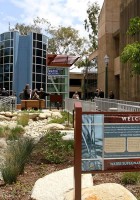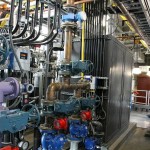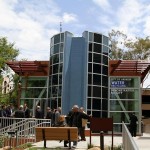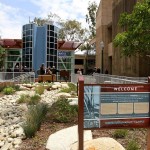Location: Anaheim, California, United States
Status: Complete
The treatment plant odor control system scrubs all the air and the facility has zero odors outside the building, a key design element given the facility is located 20-ft from Anaheim City Hall and near a major business district. The elimination of noise associated with the treatment process further required design elements to prove the facility can be situated in any urban development, with no noise and zero odor. Odor modeling and a comprehensive redundant odor system makes the wastewater treatment plant seem unnoticeable to nearby pedestrians.
As the facility was designed and constructed for demonstration purposes, over half the building is made out of glass to allow educational tours of the building from the outside. Informational signs and graphics are located around the facility to point out features of the treatment process, stormwater injection wells, landscape features and rain barrels. Visitors can witness the dark sewer influent coming into the plant through the window and a 30-ft recycle water fountain located outside the facility highlights the cleanliness of recycled water and how it can be utilized.
The WRDF was built with an ultimate treatment capacity of 100,000 gallons-per-day. Phase 1 of the project consisted of designing and building a 50,000 gallon-per-day facility, which includes an influent diversion pump station, fine screen, nitrification and denitrification tanks, membrane filtration system, ozonation system, UV disinfection system, clear well and supporting facilities such as odor control. These facilities are housed in a climate controlled, architecturally finished building. The design was completed within ten months and construction completed in 14 months. Phase 2 of the project will add another filter in the existing building to expand recycle water service to a nearby ice skating rink and park.
MWH utilized Building Information Modeling (BIM) software to help optimize the layout and improve access for operators and construction sequencing thus reducing logistical issues given the small footprint of the site. This model was pivotal in providing lean construction methods for the contractor and early collaboration between the design and construction teams.
The Anaheim Water Recycling Demonstration Facility is very unique, in that it is an example of how recycled water treatment plants can be constructed in similar downtown environments to meet water demands and provide sustainable developments. This is an innovative contribution to the community to improve sustainable development and educate the importance of water reuse.

 English
English Dutch
Dutch Turkish
Turkish


